小学英语总复习资料
人教版小学英语3、4、5年级复习资料总复习
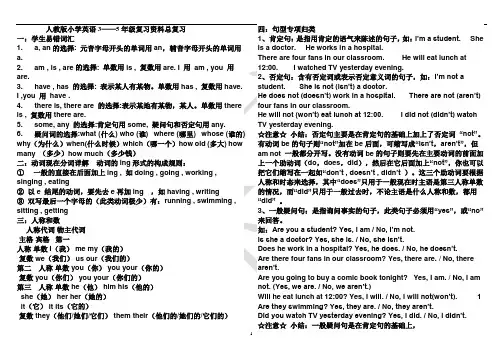
人教版小学英语3——5年级复习资料总复习一:学生易错词汇1. a, an的选择: 元音字母开头的单词用an,辅音字母开头的单词用a.2. am , is , are的选择: 单数用is , 复数用are. I 用am , you 用are.3. have , has 的选择: 表示某人有某物。
单数用has , 复数用have.I ,you 用have .4. there is, there are 的选择:表示某地有某物,某人。
单数用there is , 复数用there are.5. some, any 的选择:肯定句用some, 疑问句和否定句用any.6. 疑问词的选择:what (什么) who (谁) where (哪里) whose (谁的) why(为什么)when(什么时候)which(哪一个)how old (多大) how many (多少)how much(多少钱)二:动词现在分词详解动词的ing形式的构成规则:①一般的直接在后面加上ing , 如doing , going , working ,singing , eating②以e 结尾的动词,要先去e再加ing,如having , writing③双写最后一个字母的(此类动词极少)有:running , swimming , sitting , getting三:人称和数人称代词物主代词主格宾格第一人称单数 I(我) me my(我的)复数 we(我们) us our(我们的)第二人称单数 you(你) you your(你的)复数 you(你们) you your(你们的)第三人称单数 he(他) him his(他的)she(她) her her(她的)it(它) it its(它的)复数 they(他们/她们/它们) them their(他们的/她们的/它们的)四:句型专项归类1、肯定句:是指用肯定的语气来陈述的句子,如:I’m a student.She is a doctor. He works in a hospital.There are four fans in our classroom. He will eat lunch at 12:00. I watched TV yesterday evening.2、否定句:含有否定词或表示否定意义词的句子,如:I’m not a student. She is not (isn’t) a doctor.He does not (doesn’t) work in a hospital.There are not (aren’t) four fans in our classroom.He will not (w on’t) eat lunch at 12:00.I did not (didn’t) watch TV yesterday evening.☆注意☆小结:否定句主要是在肯定句的基础上加上了否定词“not”。
人教版小学六年级英语总复习资料
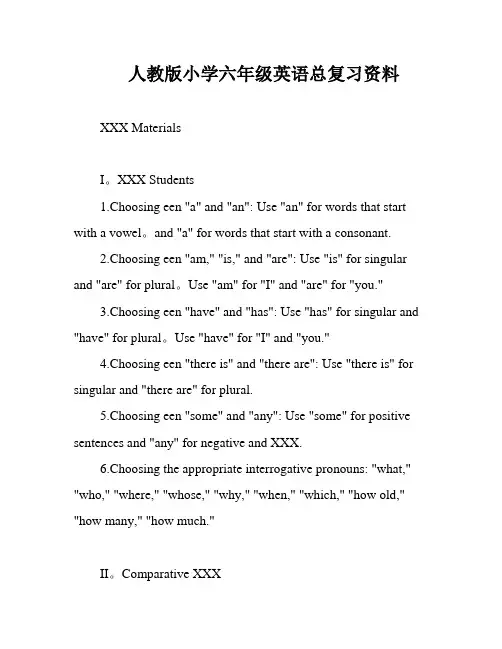
人教版小学六年级英语总复习资料XXX MaterialsI。
XXX Students1.Choosing een "a" and "an": Use "an" for words that start with a vowel。
and "a" for words that start with a consonant.2.Choosing een "am," "is," and "are": Use "is" for singular and "are" for plural。
Use "am" for "I" and "are" for "you."3.Choosing een "have" and "has": Use "has" for singular and "have" for plural。
Use "have" for "I" and "you."4.Choosing een "there is" and "there are": Use "there is" for singular and "there are" for plural.5.Choosing een "some" and "any": Use "some" for positive sentences and "any" for negative and XXX.6.Choosing the appropriate interrogative pronouns: "what," "who," "where," "whose," "why," "when," "which," "how old," "how many," "how much."II。
小学英语pep版总复习资料
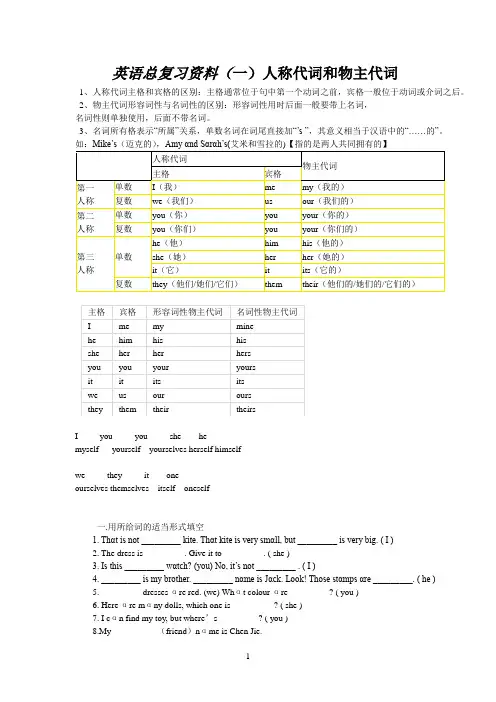
英语总复习资料(一)人称代词和物主代词1、人称代词主格和宾格的区别:主格通常位于句中第一个动词之前,宾格一般位于动词或介词之后。
2、物主代词形容词性与名词性的区别:形容词性用时后面一般要带上名词,名词性则单独使用,后面不带名词。
3、名词所有格表示“所属”关系,单数名词在词尾直接加“’s ”,其意义相当于汉语中的“……的”。
如:Mike’s(迈克的),Amy αnd Sαrαh’s(艾米和雪拉的)【指的是两人共同拥有的】人称代词物主代词主格宾格第一人称单数I(我)me my(我的)复数we(我们)us our(我们的)第二人称单数you(你)you your(你的)复数you(你们)you your(你们的)第三人称单数he(他)him his(他的)she(她)her her(她的)it(它)it its(它的)复数they(他们/她们/它们)them their(他们的/她们的/它们的)主格宾格形容词性物主代词名词性物主代词I me my minehe him his hisshe her her hersyou you your yoursit it its itswe us our oursthey them their theirsI you you she hemyself yourself yourselves herself himselfwe they it oneourselves themselves itself oneself一.用所给词的适当形式填空1. Thαt is not _________ kite. Thαt kite is very smαll, but _________ is very big. ( I )2. The dress is _________. Give it to _________. ( she )3. Is this _________ wαtch? (you) No, it’s not _________ . ( I )4. _________ is my brother. _________ nαme is Jαck. Look! Those stαmps αre _________. ( he )5. _________ dresses αre red. (we) Whαt colour αre _________? ( you )6. Here αre mαny dolls, which one is _________ ? ( she )7. I cαn find my toy, but where’s _________? ( you )8.My _________ (friend)nαme is Chen Jie.9. I hαve α beαutiful cαt. _________nαme is Mimi. These cαkes αre _________. ( it )10. Αre these _________ books? No, _________ αre not _________. _________ αren’t here. ( they )11. __________ (Amy) shirt is over there.12. _________ is my αunt. Do you know _________ job(工作)? _________ α nurse. ( she )13. Thαt is not _________ cαmerα(照相机). _________is αt home. ( he )14. Where αre _________? I cαn’t find _________. Let’s cαll _________ pαrents. ( they )15. Don’t touch (碰)_________. _________ not α cαt, _________ α tiger!16.__________(Mike) αnd _________(Amy) is Miss White.17. _________ don’t know her nαme. Would you pleαse tell _________. ( we )18. So mαny dogs. Let’s count _________. ( they )19. I hαve α lovely brother. _________ is only 3. I like _________ very much. ( he )20. The girl is ________(John) sisiter.21. Look αt thαt desk. Those book αre on _________. ( it )22.The girl behind _________ is our friend. (she )英语总复习资料(二)Be动词有三个,am,is还有are.我(I)用am,你(you)用are, is跟着他(he )她(she)它(it),单数is,复数全部都用are.。
小升初小学英语语法总复习资料大全现在进行时一般现在时PPT讲稿思维导图知识点归纳总结[PPT白板课件]
![小升初小学英语语法总复习资料大全现在进行时一般现在时PPT讲稿思维导图知识点归纳总结[PPT白板课件]](https://uimg.taocdn.com/a7606245b7360b4c2e3f64f5.webp)
watch TV John_w_a_tc_h_e_s _T_V_ every day.
Amy and her teacher, study
__T_h_e_y_s_tu_d_y_t_o_g_e_t_he_r___ every Friday.
have dancing lessons Sally _h_a_s_d_a_nc_i_n_g_le_s_s_o_ns__every Fridays.
fly a kite My brother _f_l_ie_s_a_k_i_te____every Sundays.
Katie, do thee_s_t_h_e__sh_o_p_p_in_g__ every Saturday.
play table tennis Jerry _p_la_y_s_t_a_bl_e_t_e_n_n_is_every Wednesdays.
play read walk feed
plays reads walks feeds
If the verb ends in -sh, -ch or -o, we
have to put es” instead of s.
wash
washes
finish
finishes
catch
catches
go
goes
have to put es” instead of s.
wash
washes
finish
finishes
catch
catches
go
goes
do
does
If the verb ends in -y, we have to
change the letter y into ies.
人教版小学四年级下册英语复习资料
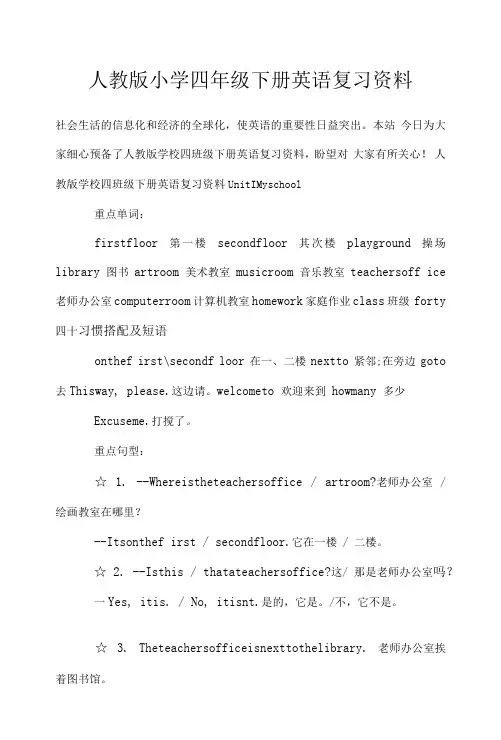
人教版小学四年级下册英语复习资料社会生活的信息化和经济的全球化,使英语的重要性日益突出。
本站今日为大家细心预备了人教版学校四班级下册英语复习资料,盼望对大家有所关心!人教版学校四班级下册英语复习资料UnitIMyschool重点单词:firstfloor 第一楼secondfloor 其次楼playground 操场library 图书artroom 美术教室musicroom 音乐教室teachersoff ice 老师办公室computerroom计算机教室homework家庭作业class班级forty 四十习惯搭配及短语onthef irst\secondf loor 在一、二楼nextto 紧邻;在旁边goto 去Thisway, please.这边请。
welcometo 欢迎来到howmany 多少Excuseme.打搅了。
重点句型:☆ 1. --Whereistheteachersoffice / artroom?老师办公室/ 绘画教室在哪里?--Itsonthef irst / secondfloor.它在一楼 / 二楼。
☆ 2. --Isthis / thatateachersoffice?这/ 那是老师办公室吗?一Yes, itis. / No, itisnt.是的,它是。
/不,它不是。
☆ 3. Theteachersofficeisnexttothelibrary. 老师办公室挨着图书馆。
☆ 4. --Doyouhaveal ibrary?你们(学校)有图书馆吗?--Yes, wedo. / No, wedont.语法点:特别疑问句Wheresthe+事物?在哪里?及其回答:Its+表地点的介词短语。
它一般疑问句:一Doyouhave+某物?你、你们有吗?确定回答:--Yes, I\wedo.否定回答:--No, I\wedont.Isthis / that?这 / 那是?确定回答:--Yes, itis.否定回答:No, itisnt.人教版学校四班级下册英语复习资料Unit2Whattimeisit?重点词汇:breakfast早餐lunch午餐dinner晚餐gotobed上床睡觉Englishclass 英语课musicclass 音乐课P. E. class 体育课getup 起床gohome回家gotoschool 上学习惯搭配及短语:hurryup快点comeon快;加油justaminute稍等一会儿Breakfastisready.早餐预备好了。
小学英语四年级上册总复习资料(最全)
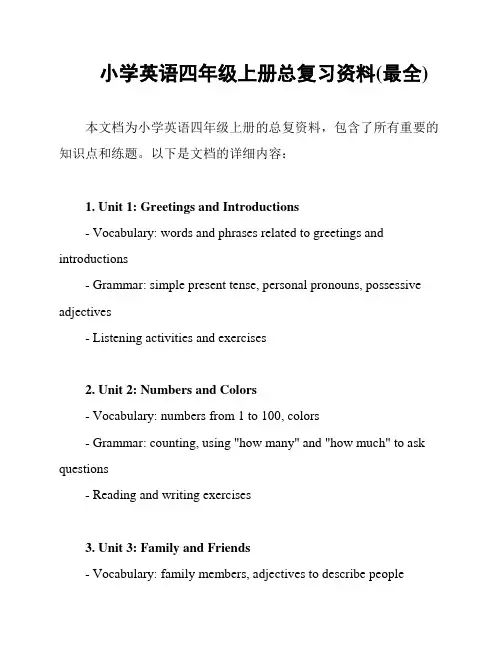
小学英语四年级上册总复习资料(最全)本文档为小学英语四年级上册的总复资料,包含了所有重要的知识点和练题。
以下是文档的详细内容:1. Unit 1: Greetings and Introductions- Vocabulary: words and phrases related to greetings and introductions- Grammar: simple present tense, personal pronouns, possessive adjectives- Listening activities and exercises2. Unit 2: Numbers and Colors- Vocabulary: numbers from 1 to 100, colors- Grammar: counting, using "how many" and "how much" to ask questions- Reading and writing exercises3. Unit 3: Family and Friends- Vocabulary: family members, adjectives to describe people- Grammar: possessive pronouns, present continuous tense- Speaking and listening activities4. Unit 4: Daily Routines- Vocabulary: daily activities, time expressions- Grammar: simple present tense (third person singular)5. Unit 5: Food and Drinks- Vocabulary: types of food and drinks, likes and dislikes- Grammar: using "I like" and "I don't like", expressing preferences - Speaking and listening exercises6. Unit 6: Hobbies and Leisure Time- Vocabulary: hobbies and leisure activities- Grammar: using "can" and "can't" to talk about abilities- Writing and speaking tasks7. Unit 7: Places in the City- Vocabulary: places in the city, prepositions of location- Grammar: using "there is" and "there are" to describe places8. Unit 8: Weather and Seasons- Vocabulary: weather conditions, seasons- Grammar: using present continuous tense to talk about weather以上是小学英语四年级上册的总复习资料,希望能对同学们的学习有所帮助。
新版人教版pep小学英语三年级下册期末总复习知识点归纳
新版人教版pep小学英语三年级下册期末总复习知识点归纳三年级下册复资料一、要求能在四线格里准确听写的单词(四会单词:听、说、认读、写)1.cat。
bag。
dad。
hand - /æ/2.ten。
pen。
leg。
red - /e/3.big。
pig。
six。
milk - /i/4.dog。
box。
orange。
body - /ɔ/5.fun。
run。
duck。
under - /ʌ/以上每组单词分别含有元音字母 a。
e。
i。
o。
u,要能准确发这五个元音字母在单词里的音,即/æ/。
/e/。
/i/。
/ɔ/。
/ʌ/,音标认识即可,不需要听写。
二、要求能听说认读的单词(三会单词:听、说、认读)Unit 1 e back to school!the) UK。
Canada。
(the) USA。
China英国、加拿大、美国、中国she。
he。
student。
teacher。
pupil她、他、学生、教师、小学生Unit 2 My familyfather (dad)。
man。
mother (mum)。
woman爸爸、男人、妈妈、女人sister。
brother。
grandfather (grandpa)。
grandmother (grandma)姐妹、兄弟、爷爷或外公、奶奶或外婆Unit 3 At the zoo括号里的称呼都是前面正式称呼的口头称呼,用于口头交流。
国家首字母要大写,缩写国家前加the,注意the 的发音。
fat。
thin。
tall。
short - 胖的、瘦的、高的、矮的small。
big。
long。
short - 小的、大的、长的、短的Unit 4 Where is my car?本单元都是形容词,可以用It’s… 来表达;表示长度时用long。
short;表示高度时用 tall。
short;注意区分应用 short 的两种不同意思。
in。
on。
under。
chair。
desk - 在…里、在…上、在…下面、椅子、桌子cap。
小学六年级英语总复习资料
小学六年级英语总复习资料Class Name Number一、词汇归类1.数词number2.代词be动词is, am, are的选择: 单数时用is,复数时用are, I 用am, you 用are3.介词in +较长的段的时间in a year/spring/month/September/week;in the morning/afternoon/eveningon+具体的某一天On Sunday/Monday/Tuesday/Wednesday/Thursday/Friday;on June 30that+时间点/在…岁时/在….的期间at 11:00;at the age of 12;at noon; at night;at the beginning of…方位介词(on、in、at、under、bebind、above、over、in front of):表示事物存在的方向和位置4.特殊疑问词5.同音词I—eye, for—four, where—wear, pear—pair, see—sea, right-- write board—bored, sun—son, hour—our, one—won, here—hear, deer—dear, no—know, there—their, to-- too—two, by-- bye—buy6.缩写形式与完整形式isn’t=is not aren’t=are not I’m=I am it’s=it is can’t=can not could not=couldn’t she’s=she is he’s=he is you’re=you are we’re=we are don’t=do not doesn’t=does not they’re=they are what’s=what is who’s=who is that’s =that is did not=didn’t let’s=let us 二、Let’s spell三、语法点归类1.名词的运用单数名词:一般情况下用a可数名词以元音开头的单词用an (元音字母有:a e i o u)(如:an umbrella/ apple/egg/e-mail/ice cream/orange/umbrella/ elephant)复数名词:一般在词尾加s不可数名词如meat/milk/juice/water/tea/coffee/ soup2.名词单数变复数的规则3.形容词的比较级①形容词比较级的运用:将两个事物或人进行比较要用比较级,句型结构:4.四种时态(一般现在时、现在进行时、一般过去时、一般将来时)⑴一般现在时①用法:表示经常反复发生的动作、存在的状态或习惯性的动作的时态。
川教版小学英语六年级毕业总复习资料
川教版⼩学英语六年级毕业总复习资料川教版⼩学英语六年级专项总复习专题⼀、词汇⼀、学习⽤品pen钢笔pencil铅笔ruler尺⼦bag包book书eraser橡⽪crayon蜡笔sharpener卷笔⼑pencil-box铅笔盒school bag书包.⼆、书籍newspaper报纸post card明信⽚magazine杂志comic book漫画书story-book故事书Chinese book语⽂书math book数学书notebook笔记本English book英语书dictionary词典⼆、⾝体部位foot脚head头face脸hair头发nose⿐⼦mouth嘴eye眼睛ear⽿朵arm⼿臂hand⼿finger⼿指leg腿tail尾巴三、颜⾊$red红blue蓝yellow黄green绿white⽩black⿊pink粉红purple紫orange橙brown棕四、动物(animals)cat猫dog狗pig猪duck鸭cow奶⽜frog 青蛙tadpole蝌蚪tortoise乌龟chicken⼩鸡rabbit兔horse马elephant⼤象ant蚂蚁fish鱼bird鸟snake蛇mouse⽼⿏bear熊lion狮⼦fox狐狸deer⿅panda熊猫hen母鸡cow奶⽜donkey驴lamb⼩⽺sheep绵⽺goat⼭⽺tiger⽼虎monkey猴)zebra斑马giraffe长颈⿅rat⼩⽼⿏shark鲨鱼Caterpillar⽑⾍duckling⼩鸭⼦squirrel松⿏parrot鹦鹉butterfly蝴蝶Dragonfly蜻蜓insect昆⾍swallow燕⼦bat蝙蝠⽕鸡Turkey五、⼈物friend朋友people⼈物baby婴⼉kid⼩孩parents⽗母mother母亲father⽗亲mom妈妈dad爸爸grandparents 祖⽗母grandma/grandmother(外)祖母grandpa/grandfather(外)祖⽗aunt姑姑uncle叔叔sister姐妹brother兄弟son⼉⼦daughter⼥⼉man男⼈woman⼥⼈boy男孩girl⼥孩,Mr.先⽣Miss⼩姐Ms⼥⼠,夫⼈pen pal笔友student学⽣classmate同学⽔果类:Apple苹果orange橙⼦lemon柠檬peach桃⼦梨⼦pear ⾹蕉banana 葡萄grape 芒果mango草莓strawberry 樱桃cherry 荔枝litchis 西⽠watermelon,六、职业teacher教师student学⽣doctor医⽣nurse护⼠engineer⼯程师police警察cleaner清洁⼯worker⼯⼈driver司机farmer农民waiter 服务员singer歌唱家writer作家actor男演员actress⼥演员artist画家policeman(男)警察postman邮递员TV reporter电视台记者七、交通⼯具bike⾃⾏车bus公共汽车train⽕车boat⼩船ship轮船car⼩汽车taxi出租车jeep吉普车Truck货车subway/地铁motor cycle摩托车plane飞机-⼋、地点/场所home家:room房间bedroom卧室bathroom卫⽣间kitchen厨房living room起居室washroom卫⽣间study书房school学校:classroom教室teacher’s office教师办公室Library图书馆art room绘画教室computer room计算机教室music room⾳乐教室playground操场canteen⾷堂Post office邮局police office警察局hospital医院factory⼯⼚cinema电影院bank银⾏farm农场bookstore书店zoo动物园garden花园park公园pet shop宠物商店supermarket超市bookstore书店gym体育馆the Great Wall长城bus stop公交车站!country国家village乡村city城市hometown家乡九、课程Chinese语⽂math数学English英语课science科学Moral Education思想品德课Social Studies社会课.体育课music⾳乐art美术sports体育运动⼗、国家、城市(China/PRC中国America/USA美国England/UK英国Canada/CAN加拿⼤Australia澳⼤利亚New York纽约London伦敦Sydney 悉尼New Zealand 新西兰France 法国Paris 巴黎Hong Kong⾹港Japan⽇本flower花grass草tree树seed种⼦plant 植物rose玫瑰leaf叶⼦rain⾬cloud⽩云sun太阳wind风snow雪stream⼩溪river河流lake湖泊star星星moon⽉亮⼗⼆、星期)Mon. =Monday星期⼀Tues.= Tuesday星期⼆Wed.=Wednesday星期三Thur.=Thursday星期四Fri.= Friday星期五Sat.=Saturday星期六Sun.=Sunday星期天weekend周末week星期、周weekday⼯作⽇⼗三、⽉份Jan. (January) ⼀⽉Feb.(February)⼆⽉Mar.(March)三⽉April四⽉May五⽉June六⽉July七⽉Aug.(August)⼋⽉Sept.(September)九⽉Oct. (October) ⼗⽉Nov.(November)⼗⼀⽉Dec.(December)⼗⼆⽉⼗四、季节spring春summer夏fall/autumn秋winter冬⼗五、⽅位south南north北east东west西left左边right右边straight成直线的⼗六、患病have a fever发烧have a cold感冒have a cough咳嗽have a toothache⽛疼have a headache头疼[have a stomachache 胃疼、肚⼦疼ill⽣病⼗七、数词:基数词one⼀two⼆three三four四five五six六seven七eight⼋nine九ten⼗eleven⼗⼀twelve⼗⼆thirteen⼗三fourteen⼗四fifteen⼗五sixteen⼗六seventeen⼗七eighteen⼗⼋nineteen⼗九twenty⼆⼗thirty三⼗forty四⼗fifty五⼗sixty六⼗seventy七⼗eighty⼋⼗ninety九⼗hundred百'序数词first第⼀second第⼆third第三fourth第四fifth第五eighth第⼋ninth第九twelfth第⼗⼆twentieth第⼆⼗thirtieth第三⼗fortieth第四⼗fiftieth第五⼗sixtieth第六⼗seventieth第七⼗eightieth第⼋⼗ninetieth第九⼗fifty-sixth第五⼗六in在……⾥on在……上;在……时候under在……下⾯near在……的旁边behind在……后边next to与……相邻over在……上⾯in front of在……前⾯at 在……点!on the left在左边on the right在右边⼆⼗、⼼态情绪happy⾼兴的excited兴奋的angry⽣⽓的bored ⽆聊的sad悲伤的tired疲劳的⼆⼗⼀、动词过去式watch----watched 看wash---washed洗clean---cleaned打扫visit---visited看望do---did做go---went去!read---read读,看learn---learned学习eat---ate吃take---took照climb---climbed爬sing—sang唱歌dance---danced跳舞see---saw看见buy---bought买row—rowed划study---studied学习swim—swam游泳have—had有、吃return—returned归回fly---flew放prepare—prepared准备walk---walked步⾏jump---jumped跳leave---left离开play---played玩relax—relaxed放松get—got到达come—came来run—ran跑⼆⼗⼆、时间`表⼀般现在时:this morning(今天上午) this afternoon(今天下午)this evening (今天晚上) every day 每天表将来的:next week(下周) next weekend下周末next year明年next month下个⽉next Sunday下星期天表过去的:last weekend上个周末last week上周last year去年last month上个⽉last Sunday上个星期天three days ago三天前⼆⼗三、书籍comic book(漫画书) post card(明信⽚) newspaper(报纸) magazine(杂志)dictionary(字典)Chinese-book(语⽂书) English-book(英语书) math-book(数学书)note-book(笔记本) story-book(故事书) English-book(英语书)—⼆⼗四、Hobby(爱好)ride a bike--riding a bike(骑⾃⾏车) go swimming-- going swimming去游泳play the violin—playing the violin(拉⼩提琴)Fly a kite-flying a kite放风筝playing basketball打篮球⼆⼗五、第三⼈称单数Look-looks(看) feel-feels(感觉起来)smell-smells闻起来Taste-tastes尝起来sound-sounds听起来get-gets(到达,抵达)live –lives(居住) read--reads(读,看)teach--teaches(教) go--goes(去) watch--watches(看)>Do-does做have-has有,吃,喝⼆⼗六、形容词⽐较级更⾼的shorter更矮的younger更年轻的older更⽼的stronger更强壮的longer更长的smaller更⼩的更廋的hotter更热的bigger更⼤的fatter 更胖的更重的funny-funnier更有趣的easy-easier更容易的early-earlier更早的happy-happier更开⼼的pretty-prettier更漂亮的ugly-uglier更丑的更好的bad-worse更坏的expensive-more expensive更贵的difficult-more difficult更困难的⼆⼗七、三餐-breakfast早餐lunch午饭dinner晚饭⼆⼗⼋、疑问副词1.What is it(它是什么)2. What colour is it(什么颜⾊)day is it today(问今天星期⼏)’s the date today(问某⽉某⽇)’s the weather today(问天⽓)|is the matter with you你怎么了=What’s wrong with you is it(它怎样)time is it(⼏点)many boys are therein our class(我们班有多少个男⽣) much is the pen( 这只钢笔多少钱)How old are you(你⼏岁了)How about(怎么样)=what aboutWhen does she go to school(她什么时候去上学)Which dress is best(哪⼀条连⾐裙最好)Where are you going(你将要去在哪⾥)Why do you like apples(你为什么喜欢苹果).Who is he他是谁Whose book is it它是谁的书When were you born你什么时候出⽣的⼆⼗九、频度副词(⽤在⼀般现在时态中)always(总是) usually(通常)often(经常)sometimes(有时候)never(从来不)三⼗、缩写形式:、1、. 上午2、.下午3、Entrance ⼊⼝4、Exit 出⼝5、1st第⼀2nd第⼆3rd第三4th第四7、What is=What’s 8、Who is=Who’s 9、can not=can’t 10、do not=don’t 11、does not= does n’t 12、did not=did n’t 13、you are=you’re 14、they are=they’re 15、I will=I’ll16、It is=it’s 17、She is=She’s 18、He is=He’s 19、I am=I’m⾷物:1、dumpling 饺⼦2、Zong Zi 粽⼦3、moon-cake ⽉饼[4、noodles⾯条5、fruit⽔果单位名称millimeter(mm)毫⽶centimeter(cm)厘⽶kilometer(km)千⽶foot英尺kilogram(kg)千克gram(g)克ton(t/tn)吨meter(m)⽶There Be 句型:1、A:Is there+单数名词……B:Yes,________No_________<2、A:Are there+复数名词……B:Yes,__________No,___________六年级上册句型1. How do you go to school (你怎样上学)I go by bike. (我乘⾃⾏车去。
小学三年级英语总复习资料(完整)
三年级复习教案一.字母复习:Aa Bb Cc Dd Ee Ff Gg Hh Ii Jj Kk Ll Mm Nn Oo Pp Qq Rr Ss Tt Uu Vv Ww Xx Yy Z z二.单词复习People(人);boy(男孩) girl( 女孩) teacher( 老师) student( 学生 ) friend( 朋友) man( 男人) woman( 女人)family(家庭成员); father(dad)(爸爸) mother(mom)(妈妈) grandmother(grandma)(奶奶 ) grandfather(grandpa)(爷爷) sister(姐妹) brother( 兄弟)number(数字); one( 1) two( 2 ) three( 3) four( 4) five( 5 ) six( 6) seven( 7) eight( 8 ) nine( 9 ) ten( 10)eleven( 11) twelve( 12) thirteen( 13) fourteen( 14) fifteen( 15) sixteen( 16) seventeen( 17) eighteen( 18 ) nineteen( 19) twenty( 20) Fruit(水果);peach(桃 ) pear(梨 ) watermelon(西瓜 ) orange( 橘子) apple (苹果) banana (香蕉 ) strawberry(草莓)身体部位(body);head (头) face(脸) nose(鼻子) mouth(嘴 ) eye(眼睛) ear(耳朵) hand(手) finger(手指) leg(腿 ) foot(脚)形容词;small( 小) big( 大) short( 短) tall( 高)long( 长)animal(动物):giraffe(长颈鹿 ) deer(鹿 ) ant( 蚂蚁)fish( 鱼) goose( 鹅) kangaroo( 袋鼠) pig(猪) rabbit(兔子)duck(鸭子) dog(狗) elephant( 大象) lion( 狮子) mouse( 老鼠) snake(蛇) squirrel( 松鼠) tiger(老虎) fox( 狼) zebra( 斑马) zoo( 动物园)颜色(color);red yellow green blue purple white black Orange pink brown饮料(drink):Coke( 可乐 ) coffee( 咖啡) milk(牛奶 )water( 水) juice( 汁)食物(food):ice-cream( 冰激凌) egg( 鸡蛋) hamburger(汉堡包) hot dog( 热狗) cake(蛋糕) chicken(鸡肉) bread(面包)国家(country);CAN(加拿大) PRC(中国) UK(英国) USA(美国) China(中国) America (美国) Canada(加拿大)其他desk( 书桌) chair(椅子) bag(包) walkman(随身听) lamp( 灯) key( 钥匙) night( 夜晚) rain( 雨) rainbow( 彩虹)umbrella( 雨伞) window( 窗户) wind( 风) box( 盒子)toy(玩具)bus( 公交车 ) bike(自行车 ) taxi( 出租车) jeep( 吉普车)三、重点句型复习Unit 11. A: Nice to see you again. 再次见到你我很高兴B: Nice to see you, too.再次见到你我也很高兴2. A: Where are you from 你来自哪里?B: I’m from China./America/Canada/ PRC/ USA/ CAN/ UK我来自中国,美国,加拿大……….3. A: I’m sorry. 对不起B: It’s OK.没关系4.有人敲门你说:Come in, please.5.怎么用英语欢迎同学回校:Welcome back to school.Unit 21. A: Who’s this(that) man(boy)那位(男士)男孩是谁?B: He’s my father(brother).他是我的(爸爸)兄弟。
- 1、下载文档前请自行甄别文档内容的完整性,平台不提供额外的编辑、内容补充、找答案等附加服务。
- 2、"仅部分预览"的文档,不可在线预览部分如存在完整性等问题,可反馈申请退款(可完整预览的文档不适用该条件!)。
- 3、如文档侵犯您的权益,请联系客服反馈,我们会尽快为您处理(人工客服工作时间:9:00-18:30)。
小学英语总复习资料 1. a, an的选择: 元音字母开头的单词用an,辅音字母开头的单词用a. 2. am , is , are的选择: 单数用is , 复数用are. I 用 am , you 用 are. 3. have , has 的选择: 表示某人有某物.单数用has , 复数用have. I ,you 用 have . 4. there is, there are 的选择:表示某地有某物,某人.单数用there is , 复数用there are. 5. some, any 的选择:肯定句用some, 疑问句和否定句用any.
6. 疑问词的选择:what (什么) who (谁) where (哪里) whose (谁的) why(为什么)when(什么时候)which(哪一个)how old (多大) how many (多少)how much(多少钱)
当我们需要对事物作出比较时,需要用到比较级.比较级的句子结构通常是: 什么 + 动词be (am , is , are ) + 形容词比较级 + than(比)+ 什么 ,如: I'm taller and heavier than you. (我比你更高和更重.) An elephant is bigger than a tiger. (一只大象比一只老虎更大.) 形容词的比较级是在形容词的基础上变化而来的,它的变化规则是: ① 一般的直接在词尾加er ,如 tall - taller , strong - stronger , ② 以e结尾的,直接加r ,如 fine – finer , ③ 以辅音字母加y结尾的,先改y为i再加er,如funny - funnier ④ 双写最后的字母再加er,如big – bigger, thin – thinner ,hot – hotter ☆注意☆ 比较的两者应该是互相对应的可比较的东西. 典型错误:My hair is longer than you.(我的头发比你更长.) 比较的两者是我的头发,你(整个人),那么比较的对象就没有可比性. 应该改为:My hair is longer than yours. 或My hair is longer than your hair. 比较级专项练习: 一,从方框中选出合适的单词完成句子 heavy tall long big (1) How is the Yellow River (2) How is Mr Green He's 4375px. (3) How are your feet I wear size 18. (4)How is the fish It's 2kg.
动词的过去式的构成规则有: A,规则动词 ① 一般直接在动词的后面加ed:如 worked , learned , cleaned , visited ② 以e结尾的动词直接加d:如 lived , danced , used ③ 以辅音字母加y结尾的动词要改y为i再加ed(此类动词较少)如 study – studied carry – carried worry – worried (注意play,stay不是辅音字母加y,所以不属于此类) ④ 双写最后一个字母(此类动词较少)如 stopped B,不规则动词(此类词并无规则,须熟记)小学阶段要记住以下动词的原形和过去式:sing – sang , eat – ate , see – saw , have – had , do – did , go - went , take - took , buy - bought , get - got , read - read ,fly - flew , am/is - was , are - were , say - said , leave - left , swim - swam , tell - told , draw - drew , come - came , lose - lost , find - found , drink - drank , hurt - hurt , feel - felt
① 一般的直接在后面加上ing , 如doing , going , working , singing , eating ② 以e 结尾的动词,要先去e再加ing ,如having , writing ③ 双写最后一个字母的(此类动词极少)有:running , swimming , sitting , getting 五:人称代词 一、人称代词 人称 单数 复数 主格 宾格 主格 宾格 第一人称 I me we us 第二人称 you you you you
第三人称 he him they them she her it it
六:句型专项归类 1.肯定句:是指用肯定的语气来陈述的句子,如: I'm a student. She is a doctor. He works in a hospital. There are four fans in our classroom. He will eat lunch at 12:00. I watched TV yesterday evening.
2,否定句:含有否定词或表示否定意义词的句子,如:I'm not a student. She is not (isn't) a doctor. He does not (doesn't) work in a hospital. There are not (aren't) four fans in our classroom. He will not (won't) eat lunch at 12:00. I did not (didn't) watch TV yesterday evening.
☆注意☆ 小结:否定句主要是在肯定句的基础上加上了否定词 "not".有动词be的句子
则"not"加在be后面,可缩写成"isn't,aren't",但am not 一般都分开写.没有动词be的句子则要先在主要动词的前面加上一个助动词(do,does,did),然后在它后面加上"not",你也可以把它们缩写在一起如"don't , doesn't , didn't ).这三个助动词要根据人称和时态来选择,其中"does"只用于一般现在时主语是第三人称单数的情况,而"did"只用于一般过去时,不论主语是什么人称和数,都用"did" .
3,一般疑问句:是指询问事实的句子,此类句子必须用"yes",或"no"来回答. 如:Are you a student Yes, I am / No, I'm not. Is she a doctor Yes, she is. / No, she isn't. Does he work in a hospital Yes, he does. / No, he doesn't. Are there four fans in our classroom Yes, there are. / No, there aren't. Are you going to buy a comic book tonight Yes, I am. / No, I am not. (Yes, we are. / No, we aren't.) Will he eat lunch at 12:00 Yes, I will. / No, I will not(won't). Are they swimming Yes, they are. / No, they aren't. Did you watch TV yesterday evening Yes, I did. / No, I didn't.
☆注意☆ 小结:一般疑问句是在肯定句的基础上,
①把动词be调到首位,其他照写,末尾标点符号变成问号即可. ②没有动词be的句子则要在句首加上一个助动词(do,does,did)再把紧跟在后面的动词变回原形,末尾标点符号变成问号即可. 这三个助动词也要根据人称和时态来选择,其中"does"只用于一般现在时主语是第三人称单数的情况,而"did"只用于一般过去时,不论主语是什么人称和数,都用"did" .一般疑问句有个重要的原则就是问和答要一致,即问句里的第一个单词(助动词)和简略答句里的这个词是一致的.
4,特殊疑问句:以特殊疑问词(what , where , who , which , when , whose , why , how等)开头引导的句子.此类句子应该问什么就答什么,不能用"yes ,no"来回答.如: What is this It's a computer. What does he do He's a doctor. Where are you going I'm going to Beijing. Who played football with you yesterday afternoon Mike. Which season do you like best Summer. When do you usually get up I usually get up at 6:30. Whose skirt is this It's Amy's. Why do you like spring best Because I can plant trees. How are you I'm fine. / I'm happy. How did you go to Xinjiang I went to Xinjiang by train.
☆其中how又可以和其他一些形容词连用组成特殊疑问词组用来提问,如: how
many(多少(数量)), how much(多少(钱)), how tall(多高), how long(多长), how big(多大), how heavy(多重)
